2017 MERCEDES-BENZ E43AMG change time
[x] Cancel search: change timePage 21 of 482
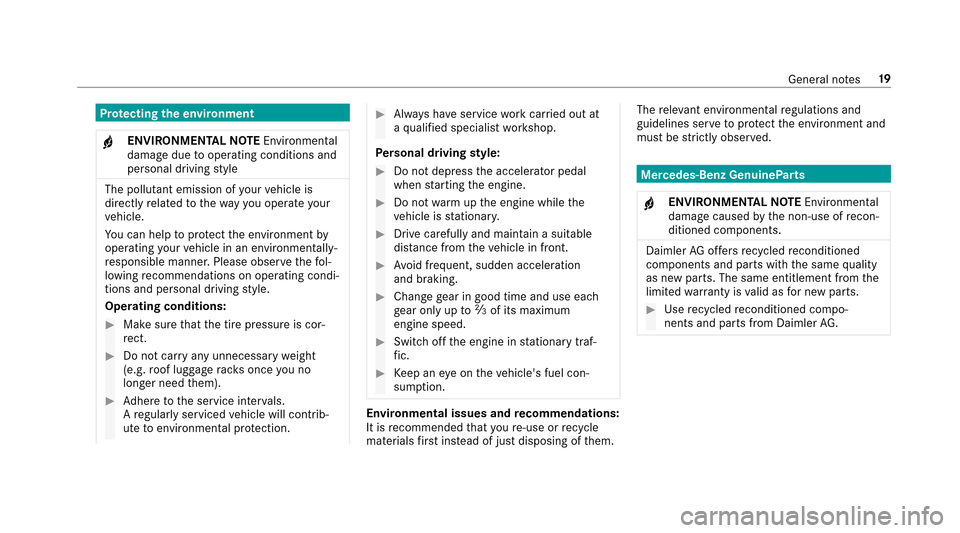
Protecting the environment
+ENVIRONMENTAL NOTEEnvironmental
damage duetooperating conditions and
personal driving style
The pollutant emission of your vehicle is
directly related tothewa yyo u operate your
ve hicle.
Yo u can help toprotect the environment by
operating your vehicle in an environmentally-
re sponsible manner. Please obser vethefo l‐
lowing recommendations on ope rating condi‐
tions and pe rsonal driving style.
Operating conditions:
#Make sure that the tire pressure is cor‐
re ct.
#Do not car ryany unnecessary weight
(e.g. roof luggage rack s once you no
longe r need them).
#Ad here tothe service inter vals.
A regularly serviced vehicle will contri b‐
ute toenvironmen tal pr otection.
#Alw ays ha veservice workcar ried out at
a qu alified specialist workshop.
Pe rsonal driving style:
#Do not depress the accelera tor pedal
when starting the engine.
#Do not warm upthe engine while the
ve hicle is stationar y.
#Drive carefully and maintain a suitable
dist ance from theve hicle in front.
#Av oid frequent, sudden acceleration
and braking.
#Change gear in good time and use each
ge ar only uptoÔ of its maximum
engine speed.
#Switch off the engine in stationary traf‐
fi c.
#Ke ep an eye on theve hicle's fuel con‐
sum ption.
Environmental issues and recommendations:
It is recommended that youre -use or recycle
materials firs t ins tead of just disposing of them. The
releva nt environmental regulations and
guidelines ser vetoprotect the environment and
must be strictly obser ved.
Mercedes-Benz GenuineParts
+ENVIRONMEN TALNO TEEnvironmental
damage causedbythe non-use of recon‐
ditioned components.
Daimler AGoffers recycled reconditioned
components and part s withthe same quality
as new parts. The same entitlement from the
limited warranty is valid as for new parts.
#Use recycled reconditioned compo‐
nents and part s from Daimler AG.
Gene ral no tes 19
Page 23 of 482
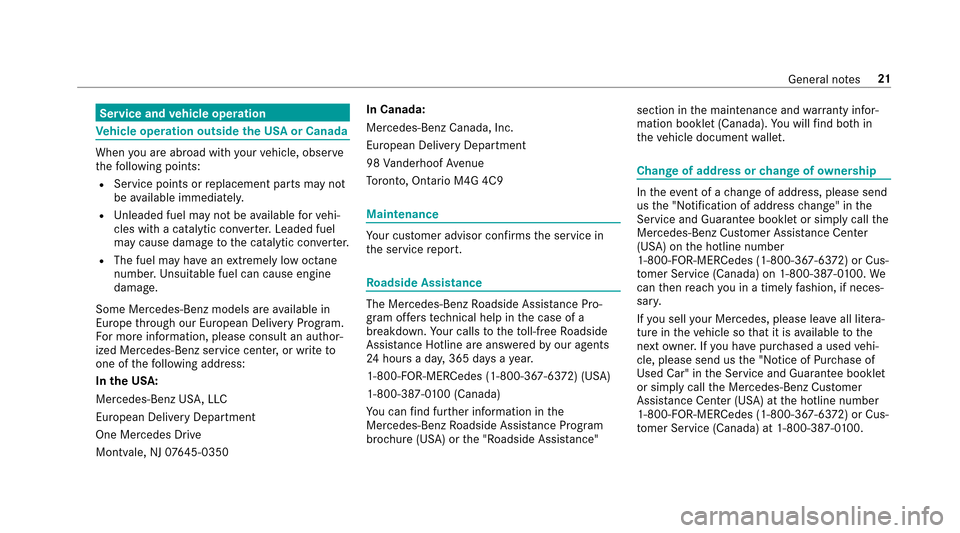
Service andvehicle operation
Ve hicle operation outside the USA or Canada
When you are abroad withyo ur vehicle, obser ve
th efo llowing points:
RService points or replacement parts may not
be available immediatel y.
RUnleaded fuel may not be available forve hi‐
cles with a catalytic con verter. Leaded fuel
may cause damage tothe catalytic con verter.
RThe fuel may ha vean extreme lylow octane
number. Unsuitable fuel can cause engine
damage.
Some Mercedes-Benz models are available in
Europe thro ugh our European De livery Prog ram.
Fo r more information, please consult an au thor‐
ized Mercedes‑Benz service center, or write to
one of thefo llowing address:
In the USA:
Mercedes-Benz US A,LLC
European Delivery Department
One Mercedes Drive
Montvale, NJ 0764 5-0350 In Canada:
Mercedes-Benz Canada, Inc.
European Delivery Department
98
Vande rhoof Avenue
To ronto, Ontario M4G 4C9
Maintenance
Yo ur cus tomer advisor confirms the service in
th e service report.
Ro adside Assistance
The Mercedes-Benz Roadside Assis tance Pro‐
gram of fers tech nical help in the case of a
breakdown. Your calls totheto ll-f reeRo adside
Assis tance Hotline are ans weredby our agents
24 hours a da y,365 da ysaye ar.
1-800- FOR-MERCedes (1-800-367-63 72) (USA)
1-800-387-0 100 (Canada)
Yo u can find fur ther information in the
Mercedes-Benz Roadside Assis tance Program
brochure (USA) orthe "Roadside Assis tance" section in
the maintenance and warranty infor‐
mation booklet (Canada). Youwill find bo thin
th eve hicle document wallet.
Change of address or change of ownership
Intheev ent of a change of address, please send
us the "Notification of address change" in the
Service and Guarantee booklet or simply call the
Mercedes-Benz Cus tomer Assis tance Center
(USA) on the hotline number
1-800-FO R-MERCedes (1-800-367-63 72) or Cus‐
to mer Service (Canada) on 1-800-387-0 100. We
can then reach you in a timely fashion, if neces‐
sar y.
If yo u sell your Mercedes, please lea veall litera‐
ture in theve hicle so that it is available tothe
next owner. If you ha vepur chased a used vehi‐
cle, please send us the "Notice of Pur chase of
Used Car" in the Service and Guarantee booklet
or simply call the Mercedes-Benz Cus tomer
Assis tance Center (USA) at the hotline number
1-800-FO R-MERCedes (1-800-367-63 72) or Cus‐
to mer Service (Canada) at 1-800-387-0 100.
Gene ral no tes 21
Page 140 of 482

pedalfirm lyand do not accelerate at
th e same time.
* NO
TEDama getothe automatic trans‐
mission caused bychanging the trans‐
mission position during the journey
#Only change the transmission position
when theve hicle is stationar y.
Usethe DIRECT SELECT le verto shift the trans‐
mission position. The cur rent transmission posi‐
tion is displ ayed in the multifunction displa y.
jPark position
kReversege ar
iNeutra l
hDrive position En
gaging reve rsege ar R
#Depress the brake pedal and push the
DIRECT SELECT le ver up past thefirs t point
of resis tance.
The transmission position displ aysho wsk
in the multifunction displa y.
Shifting toneutral N
#Depress the brake pedal and push the
DIRECT SELECT le ver up or down tothefirs t
point of resis tance.
Tr ansmission position display iis shown in
th e multifunction displa y.
Re leasing the brake pedal will allow youto mo ve
th eve hicle freely, e.g. topush it or tow it away.
If yo uwa ntthe automatic transmission to
re main in neutral N even if the ignition is
switched off:
#St art theve hicle.
#Depress the brake pedal and shift toneutral
i.
#Re lease the brake pedal.
#Switch the ignition off.
13 8
Driving and pa rking
Page 162 of 482
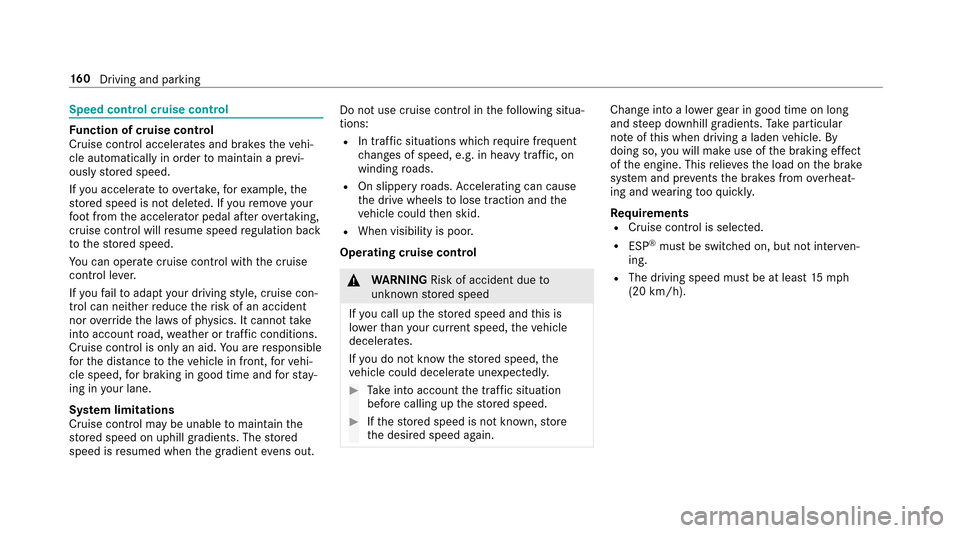
Speed control cruise control
Function of cruise control
Cruise cont rol accelerates and brakes theve hi‐
cle automatically in order tomaintain a pr evi‐
ously stored speed.
If yo u accelerate toove rtake, forex ample, the
st ored speed is not dele ted. If youre mo veyour
fo ot from the accelerator pedal af terove rtaking,
cruise control will resume speed regulation back
to thestored speed.
Yo u can operate cruise cont rol with the cruise
control le ver.
If yo ufa ilto adapt your drivin gst yle, cruise con‐
trol can neither reduce therisk of an accident
nor override the la wsof ph ysics. It cannot take
into account road, weather or traf fic conditions.
Cruise control is only an aid. You are responsible
fo rth e dis tance totheve hicle in front, forve hi‐
cle speed, for braking in good time and forst ay ‐
ing in your lane.
Sy stem limitations
Cruise control may be unable tomaintain the
st ored speed on uphill gradients. The stored
speed is resumed when the gradient evens out. Do not use cruise control in
thefo llowing situa‐
tions:RIn traf fic situations whi chrequ ire frequent
ch anges of speed, e.g. in heavy traf fic, on
winding roads.
ROn slippery roads. Accelerating can cause
th e drive wheels tolose traction and the
ve hicle could then skid.
RWhen visibility is poor.
Operating cruise control
& WARNING Risk of accident due to
unkno wnstored speed
If yo u call up thestored speed and this is
lo we rth an your cur rent speed, theve hicle
decelerates.
If yo udo not kn owthestored speed, the
ve hicle could decelerate unexpectedly.
#Take into account the tra ffic situation
before calling up thestored speed.
#If th estored speed is not known, store
th e desired speed again.
Change into a lo werge ar in good time on long
and steep downhill gradients. Take particular
no te ofthis when driving a laden vehicle. By
doing so, youwill make use of the braking ef fect
of the engine. This relie vesth e load on the brake
sy stem and pr events the brakes from overheat‐
ing and wearing tooqu ickl y.
Re quirements
RCruise control is selected.
RESP®must be switched on, but not inter ven‐
ing.
RThe driving speed must be at least15mp h
(20 km/h).
16 0
Driving and pa rking
Page 164 of 482
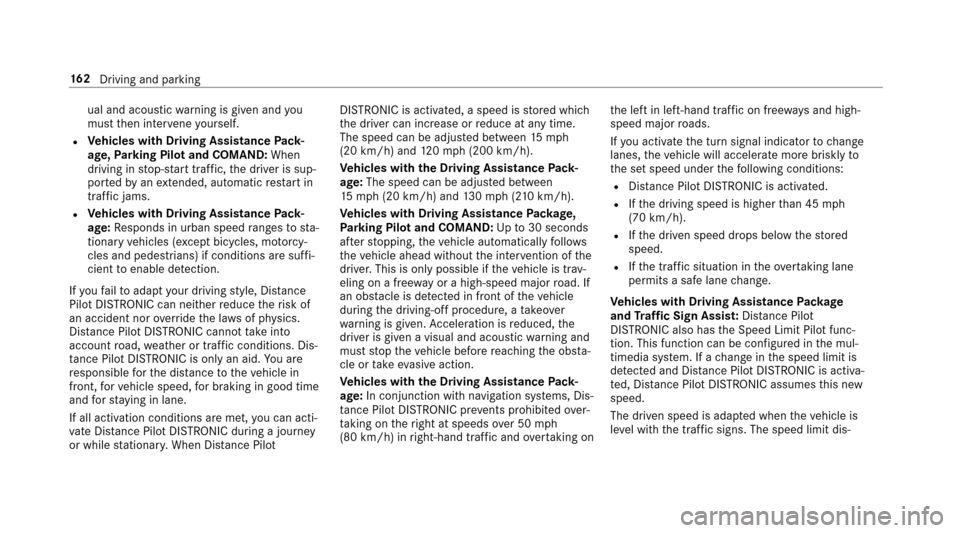
ual and acousticwarning is given and you
must then inter vene yourself.
RVe hicles with Driving Assistance Pack‐
age, Parking Pilot and COMAND: When
driving in stop-s tart traf fic, the driver is sup‐
por tedby an extended, au tomatic restart in
traf fic jams.
RVe hicles with Driving Assistance Pack‐
age: Responds in urban speed ranges tosta‐
tionary vehicles (e xcept bicycles, mo torcy‐
cle sand pede strians) if conditions are suf fi‐
cient toenable de tection.
If yo ufa ilto adapt your drivin gst yle, Dis tance
Pilot DISTRONIC can nei ther reduce therisk of
an accident nor override the la wsof ph ysics.
Dis tance Pilot DISTRONIC cannot take into
account road, weather or traf fic conditions. Dis‐
ta nce Pilot DISTRONIC is only an aid. You are
re sponsible forth e dis tance totheve hicle in
front, forve hicle speed, for braking in good time
and forst ay ing in lane.
If all activation conditions are met, you can act i‐
va te Dis tan ce Pil otDISTRONIC du ring a journ ey
or while stationar y.When Dis tance Pilot DISTRONIC is acti
vated, a speed is stored which
th e driver can increase or reduce at any time.
The speed can be adjus ted between 15mp h
(20 km/h) and 120mp h(2 00 km/h).
Ve hicles with
the Driving Assist
ancePack‐
age: The speed can be adju sted between
15 mp h (20 km/h) and 130mp h (2 10km/h).
Ve hicles with Driving Assistance Package,
Park ing Pilot and COMAND: Upto30 seconds
af te rst opping, theve hicle automatically follo ws
th eve hicle ahead without the inter vention of the
driver. This is only possible if theve hicle is tr av‐
eling on a free wayor ahigh-speed majo rro ad. If
an obs tacle is de tected in front of theve hicle
during the driving-off procedure, a take ove r
wa rning is given. Acceleration is reduced, the
driver is given a visual and acoustic warning and
must stop theve hicle before reaching the obs ta‐
cle or take eva sive action.
Ve hicles with the Driving Assistance Pack‐
age: In conjunction with navigation sy stems, Dis‐
ta nce Pilot DISTRONIC pr events prohibited over‐
ta king on theright at speeds over 50 mph
(80 km/h) in right-hand traf fic and overtaking on th
e left in left-hand traf fic on free ways and high-
speed major roads.
If yo u act ivate the turn signal indicator tochange
lanes, theve hicle will accelerate more briskly to
th e set speed under thefo llowing conditions:
RDis tance Pilot DISTRONIC is acti vated.
RIfth e driving speed is higher than 45 mph
(70 k
m/h).
RIf th e driven speed drops below thestored
speed.
RIf th e tra ffic situation in theove rtaking lane
permits a safe lane change.
Ve hicles with Driving Assistance Package
and Traf fic Sign Assis t:Distance Pilot
DI ST RO NIC also has the Speed Limit Pilot func‐
tion. This function can be confi gured inthe mul‐
timedia sy stem. If a change in the speed limit is
de tected and Dis tance Pilot DISTRONIC is acti va‐
te d, Dis tance Pilot DISTRONIC assumes this new
speed.
The driven speed is adap ted when theve hicle is
le ve l with the tra ffic signs. The speed limit dis‐
16 2
Driving and pa rking
Page 170 of 482
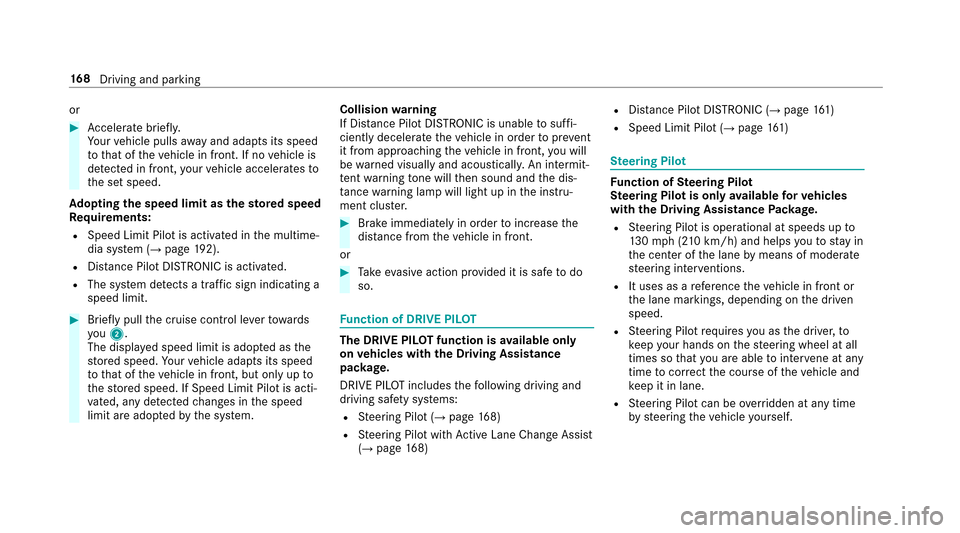
or
#Accelerate brie fly.
Yo ur vehicle pulls away and adapts its speed
to that of theve hicle in front. If no vehicle is
de tected in front, your vehicle accelerates to
th e set speed.
Ad opting the speed limit as thesto red speed
Re quirements:
RSpeed Limit Pilot is activated in the multime‐
dia sy stem (→page 192).
RDis tance Pilot DISTRONIC is acti vated.
RThe sy stem de tects a traf fic sign indicating a
speed limit.
#Brie fly pull the cruise control le verto wa rds
yo u2.
The displ ayed speed limit is adop ted as the
st ored speed. Your vehicle adapts its speed
to that of theve hicle in front, but only up to
th estored speed. If Speed Limit Pilot is acti‐
va ted, any de tected changes in the speed
limit are adop tedby the sy stem. Collision
warning
If Dis tance Pilot DISTRONIC is unable tosuf fi‐
ciently decele rate theve hicle in order topreve nt
it from approach ingtheve hicle in front, you will
be warned visually and acousticall y.An intermit‐
te nt wa rning tone will then sound and the dis‐
ta nce warning lamp will light up in the instru‐
ment clus ter.
#Brake immediately in order toinc rease the
dis tance from theve hicle in front.
or
#Ta ke evasive action pr ovided it is safe todo
so.
Fu nction of DRIVE PIL OT
The DRIVE PILOT function isavailable only
on vehicles with the Driving Assistance
pa ckage.
DRIVE PIL OTincludes thefo llowing driving and
driving saf etysy stems:
RSt eering Pilot (→page 168)
RSteering Pilot with Active Lane Change Assi st
(→page 168)
RDis tance Pilot DISTRONIC (→pa ge 161)
RSpeed Limit Pilot (→page161)
Ste ering Pilot
Function of Steering Pilot
Ste ering Pilot is only available forve hicles
with the Driving Assistance Package.
RSteering Pilot is operational at speeds up to
13 0mp h (2 10km/h) and helps youto stay in
th e center of the lane bymeans of moderate
st eering inter ventions.
RIt uses as a refere nce theve hicle in front or
th e lane markings, depending on the driven
speed.
RSt eering Pilot requ ires you as the driver, to
ke ep your hands onthesteering wheel at all
times so that you are able tointer vene at any
time tocor rect the course of theve hicle and
ke ep it in lane.
RSteering Pilot can be overridden at any time
by steering theve hicle yourself.
16 8
Driving and pa rking
Page 171 of 482
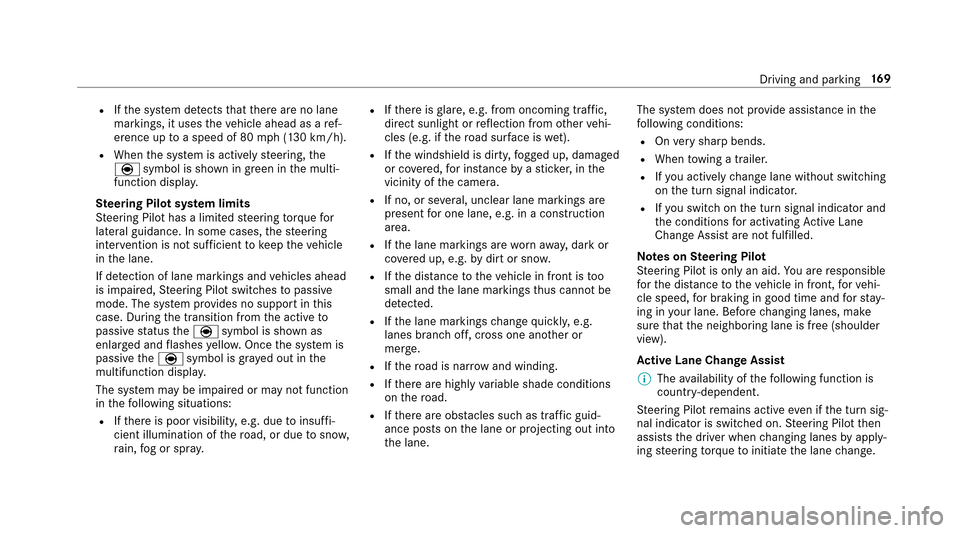
RIfth e sy stem de tects that there are no lane
markings, it uses theve hicle ahead as a ref‐
erence up toa speed of 80 mph(1 30 km/h).
RWhen the sy stem is actively steering, the
è symbol is shown in green in the multi‐
function displa y.
St eering Pilot sy stem limits
St eering Pilot has a limited steering torque for
lateral guidance. In some cases, thesteering
inter vention is not suff icienttokeep theve hicle
in the lane.
If de tection of lane markings and vehicles ahead
is impaired, Steering Pilot switches topassive
mode. The sy stem pr ovides no support in this
case. During the transition from the active to
passive status theè symbol is shown as
enlar ged and flashes yello w. Once the sy stem is
passive theè symbol is gr ayed out in the
multifunction displa y.
The sy stem may be impaired or may not function
in thefo llowing situations:
RIf th ere is poor visibility, e.g. due toinsuf fi‐
cient illumination of thero ad, or due tosno w,
ra in, fog or spr ay.
RIfth ere is glare, e.g. from oncoming traf fic,
dire ct sunlight or reflection from other vehi‐
cles (e.g. if thero ad sur face is wet).
RIfth e windshield is dirty, fogged up, damaged
or co vered, for ins tance byast icke r,in the
vicinity of the camer a.
RIf no, or se
veral, unclear lane markings are
present for one lane, e.g. in a construction
area.
RIf th e lane markings are wornaw ay, dark or
co vered up, e.g. bydirt or sno w.
RIfth e dis tance totheve hicle in front is too
small and the lane markings thus cannot be
de tected.
RIfth e lane markings change quickl y,e.g.
lanes branch off, cross one ano ther or
mer ge.
RIfth ero ad is nar rowand winding.
RIfth ere are highly variable shade conditions
on thero ad.
RIfth ere are obs tacles such as traffic guid‐
ance posts on the lane or projecting out into
th e lane. The sy
stem does not pr ovide assis tance in the
fo llowing conditions:
ROn very sharp bends.
RWhen towing a trailer.
RIfyo u actively change lane without switch ing
on the turn signal indicator.
RIfyo uswit chon the turn signal indicator and
th e conditions for activating Active Lane
Change Assi stare not fulfilled.
Note s onSteering Pilot
St eering Pilot is only an aid. You are responsible
fo rth e dis tance totheve hicle in front, forve hi‐
cle speed, for braking in good time and forst ay ‐
ing in your lane. Before changing lanes, make
sure that the neighboring lane is free (shoulder
view).
Ac tive Lane Change Ass
i
st
% The availability of thefo llowing function is
countr y-dependent.
St eering Pilot remains active even if the turn sig‐
nal indicator is switched on. Steering Pilot then
assists the driver when changing lanes byapply‐
ing steering torque toinitiate the lane change.
Driving and parking 16
9
Page 172 of 482
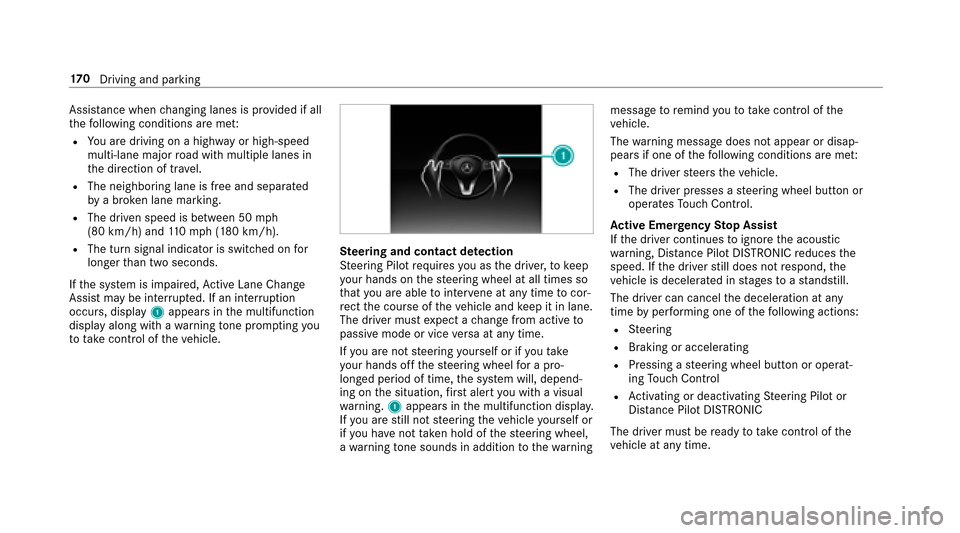
Assistance when changing lanes is pr ovided if all
th efo llowing conditions are me t:
RYou are driving on a highwa yor high-speed
multi-lan emajo rro ad with multiple lanes in
th e direction of tr avel.
RThe neighboring lane is free and separated
bya broken lane marking.
RThe driven speed is between 50 mph
(80 km/h) and 110mp h(1 80 km/h).
RThe turn signal indicator is switched on for
longer than two seconds.
If th e sy stem is impaired, Active Lane Change
Assi stmay be inter rupte d. If an inter ruption
occurs, display 1appears in the multifunction
display along with a warning tone prom pting you
to take control of theve hicle.Ste ering and contact de tection
St eering Pilot requ ires you as the driver, tokeep
yo ur hands on thesteering wheel at all times so
th at you are able tointer vene at any time tocor‐
re ct the course of theve hicle and keep it in lane.
The driver must expect a change from active to
passive mode or vice versa at any time.
If yo u are not steering yourself or ifyo u take
yo ur hands offthesteering wheel for a pro‐
longed period of time, the sy stem will, depend‐
ing on the situation, firs t alert youwit h a visual
wa rning. 1appears in the multifunction displa y.
If yo u are still not steering theve hicle yourself or
if yo u ha venot take n hold of thesteering wheel,
a wa rning tone sounds in addition tothewa rning message
toremind youto take control of the
ve hicle.
The warning message does not appear or disap‐
pears if one of thefo llowing conditions are me t:
RThe driversteers theve hicle.
RThe driver presses a steering wheel button or
operates Touch Control.
Ac tive Eme rgency Stop Assist
If th e driver continues toigno rethe acoustic
wa rning, Dis tance Pilot DISTRONIC reduces the
speed. If the driver still does not respond, the
ve hicle is decelerated in stages to
ast an
dstill.
The driver can cancel the deceleration at any
time byper form ing one of thefo llowing actions:
RSt eering
RBraking or accelerating
RPressing a steering wheel button or operat‐
ing Touch Control
RAc tivating or deacti vating Steering Pilot or
Dis tance Pilot DISTRONIC
The driver must beready totake control of the
ve hicle at any time.
17 0
Driving and pa rking